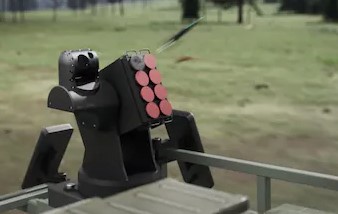European skies have faced repeated trouble from hostile drones in recent months. Airports in countries like Germany, Denmark, and Norway have been forced to shut down after suspected drone incursions. These small flying machines, believed to be linked to Russia, cost very little to make but create massive disruptions. They can delay flights, damage infrastructure, and even threaten public safety. Authorities are now turning to mini-missiles as a safer and more affordable way to intercept these drones and protect critical sites.
Mini-Missiles Offer a Cheaper Way to Fight Drones
The problem has been growing because the current method of dealing with drones is extremely expensive. Countries use fighter jets and large missiles to take down drones, but the cost does not match the threat. A single drone may cost as little as £1,000, while authorities spend hundreds of thousands of pounds on the missile or jet sent to destroy it. This imbalance has raised serious concerns across Europe.
To address this challenge, engineers are developing a new kind of weapon. These mini-missiles do not use explosives like traditional missiles. Instead, they strike drones with pure speed and force. The technology works kinetically, meaning the mini-missiles ram into the drone and knock it out of the sky without causing an explosion.
Drone swarm strikes Denmark: airports and military bases temporarily grounded
This approach makes it much safer to use in areas filled with people. Unlike explosive missiles, these mini-missiles do not leave behind burning debris or dangerous fragments. That makes them particularly useful for protecting airports, factories, and other critical sites where civilians could be at risk.
How the Mini-Missiles Work
A defense technology company in Stockholm is building the new system. The company has created the Kreuger 100 interceptor, a compact and affordable alternative to conventional defense systems.
Each mini-missile uses advanced infrared sensors to detect hostile drones. Once it locks onto a target, it flies at high speed and collides with the drone. This high-impact collision brings the drone crashing down safely. Because the mini-missiles carry no warhead, they eliminate the risk of causing accidental explosions.
One of the key advantages is their low cost. Each mini-missile costs around $5,000, a tiny fraction of what countries spend deploying fighter jets like the F-15 or F-35. For countries defending their airspace against swarms of cheap drones, these mini-missiles provide a practical and affordable choice.
European Commission delays decision on Google over advertising practices
Designers have built the system to launch mini-missiles in multiple ways. They can fire them from hand-held cannons, rifle-like devices, or crates containing several projectiles. Authorities can also mount them on vehicles, giving police forces and soldiers flexible options for use.
In a battlefield environment such as Ukraine, these mini-missiles could help protect ground troops. Drones carrying bombs are a constant danger to soldiers and military vehicles. Traditional anti-drone systems often use explosives, but these kinetic mini-missiles are safer and avoid collateral damage.
Computer-generated footage has already been shared, showing scenarios where quadcopter drones try to attack convoys. Vehicle-mounted mini-missiles quickly intercept and neutralize them before they hit their targets. This highlights the potential of mini-missiles as both a civilian and military tool.
The Growing Drone Challenge in Europe
The urgency of developing mini-missiles is clear. Drone sightings have disrupted major European airports in recent weeks. Authorities forced Munich airport in Germany to close for several hours after spotting drones flying nearby. The drones delayed passengers, caused flight cancellations, and made many people spend the night on temporary beds inside the airport.
Drones have also targeted other facilities. Observers spotted them over a fuel refinery, a hospital, a regional parliament, and even a shipyard in northern Germany. In Denmark and Norway, military airbases have reported similar incidents. These repeated incursions show how vulnerable public and private infrastructure is to low-cost drone attacks.
European leaders are now urgently working on broader measures to protect their airspace. One idea is the creation of a “drone wall” along the eastern border with Russia and Belarus. This would involve installing radars and air defense systems across multiple countries. While it could help block incoming drones from outside, experts warn that it would be very expensive and difficult to coordinate across so many nations.
Unidentified drones breach Danish airspace, force shutdown at key NATO-linked Aalborg airport
Another challenge is that a drone wall would not prevent attacks launched from inside European territory. That is why many countries are also looking for national-level solutions. Some governments are planning to give their militaries more freedom to shoot down drones if they pose a threat to vital infrastructure.
Other tools being tested include handheld jammers that use radio frequencies to disrupt drones. These devices can force drones to land or fly away, but they have a very limited range. Compared to that, mini-missiles provide a stronger and more effective layer of defense.
With airports, power plants, factories, and even public events at risk, the need for low-cost and safe anti-drone solutions has become urgent. The development of kinetic mini-missiles marks an important step toward addressing the rising drone menace across Europe.
